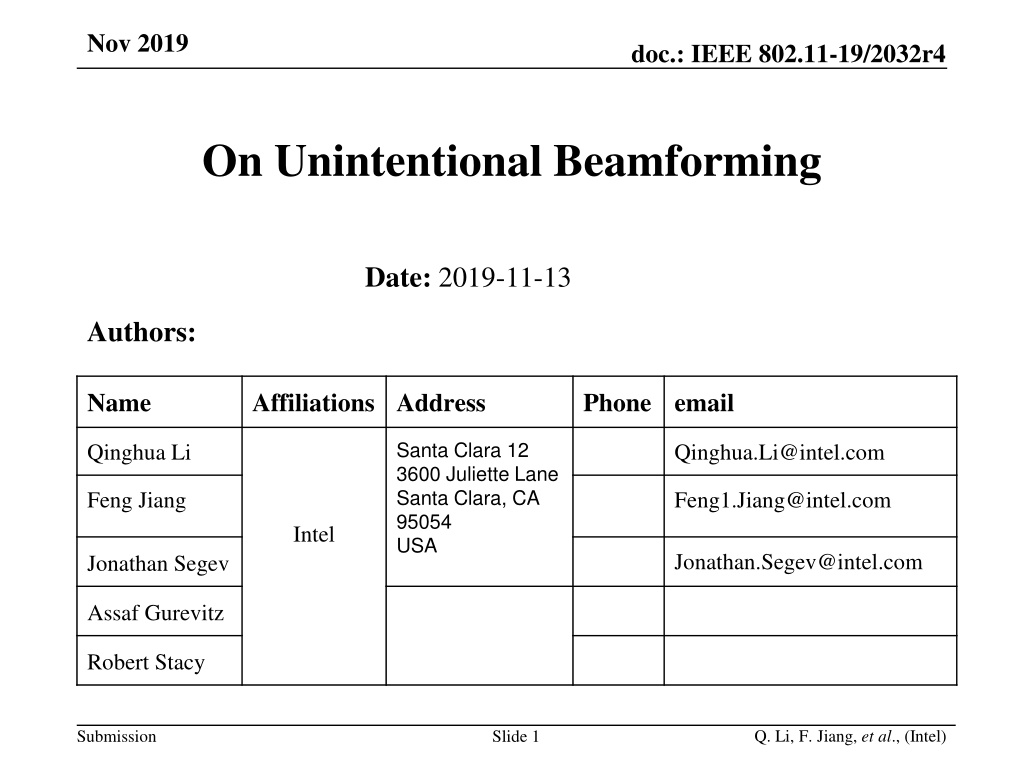Unintentional Beamforming in IEEE 802.11-19/2032r4
Contribution on unintentional beamforming in IEEE 802.11-19/2032r4 addressing potential problems and solutions for secure ranging, involving issues with signal interference and power diminishing. Discussions include the impact on received power and robustness enhancements for signal transmission.
Download Presentation

Please find below an Image/Link to download the presentation.
The content on the website is provided AS IS for your information and personal use only. It may not be sold, licensed, or shared on other websites without obtaining consent from the author.If you encounter any issues during the download, it is possible that the publisher has removed the file from their server.
You are allowed to download the files provided on this website for personal or commercial use, subject to the condition that they are used lawfully. All files are the property of their respective owners.
The content on the website is provided AS IS for your information and personal use only. It may not be sold, licensed, or shared on other websites without obtaining consent from the author.
E N D
Presentation Transcript
Nov 2019 doc.: IEEE 802.11-19/2032r4 On Unintentional Beamforming Date: 2019-11-1317-12-14 Authors: Name Affiliations Address Phone email Santa Clara 12 3600 Juliette Lane Santa Clara, CA 95054 USA Qinghua Li Qinghua.Li@intel.com Feng Jiang Feng1.Jiang@intel.com Intel Jonathan.Segev@intel.com Jonathan Segev Assaf Gurevitz Robert Stacy Q. Li, F. Jiang, et al., (Intel) Submission Slide 1
Nov 2019 doc.: IEEE 802.11-19/2032r4 Abstract Contribution, IEEE 802.11-19/1572r4, discussed a potential problem due to unintentional beamforming in 11az secure ranging. The solution proposed in 1572r4 multiplies the memory size scalar by the number of antennas for storing the secure sounding signals. This contribution depicts a simple solution, which can be implementation specific Q. Li, F. Jiang, et al., (Intel) Submission Slide 2
Nov 2019 doc.: IEEE 802.11-19/2032r4 Problem Statement (1/2) HE- STF TX antenna 1 - Signal 2 Signal 3 - Signal 4 Signal 1 HE- STF TX antenna 2 Signal 1 Signal 2 Signal 3 Signal 4 NSTS= 2 , LTFREP= 2 The signals sent by antennas 1 and 2 are the same except the global phases may be different The received signals may superimpose each other constructively and destructively Q. Li, F. Jiang, et al., (Intel) Submission Slide 3
Nov 2019 doc.: IEEE 802.11-19/2032r4 Problem Statement (2/2) HE- STF TX antenna 1 Signal 1 - Signal 2 Signal 3 - Signal 4 HE- STF TX antenna 2 Signal 1 Signal 2 Signal 3 Signal 4 9.6us RX RSSI Constructive interference Destructive interference Zero GI Unintentional beamforming may cause received signal level stays low for 9.6 us Q. Li, F. Jiang, et al., Submission Slide 4 (Intel)
Nov 2019 doc.: IEEE 802.11-19/2032r4 Discussions The diminishing of received power may only happen for short distance and LOS channels with ideal antenna radiation patterns The current 11az spec draft meets the regulation requirements WiFi-compliant device will not transmit due to the power diminishing Q. Li, F. Jiang, et al., (Intel) Submission Slide 5
Nov 2019 doc.: IEEE 802.11-19/2032r4 Robustness Enhancement Adding Delayed Signal HE- STF Signal 1 - Signal 2 Signal 3 - Signal 4 TX antenna 1 HE- STF 1 ?2 Signal 1 Signal 2 Signal 3 Signal 4 TX antenna 2 HE- STF Signal 1 Signal 2 Signal 3 Signal 4 TX power splitting and random phase rotation Linear or CSD shifts Q. Li, F. Jiang, et al., (Intel) Submission Slide 6
Nov 2019 doc.: IEEE 802.11-19/2032r4 No Effect to ToA Measurement 1 Multipaths for TX antenna 1 Delay ToA 1 ?2 Multipaths for TX antenna 2 Delay Multipaths for TX signal delayed Multipaths for TX signal not delayed Since the delayed transmission only introduces multipaths after the first channel arrival, it doesn t affect the ToA estimation Q. Li, F. Jiang, et al., (Intel) Submission Slide 7
Nov 2019 doc.: IEEE 802.11-19/2032r4 Example Assuming two antennas have the same channel response i.e. 1 HE- STF 1 TX antenna 1 Signal 1 - Signal 2 Signal 3 - Signal 4 HE- STF Signal 1 Signal 2 Signal 3 Signal 4 1 ?2 TX antenna 2 HE- STF Signal 1 Signal 2 Signal 3 Signal 4 2 + 2 1 ?2 2 2 2 1 ?2 RX RSSI Q. Li, F. Jiang, et al., (Intel) Submission Slide 8
Nov 2019 doc.: IEEE 802.11-19/2032r4 Stabilized Received Power Assuming two antennas have the same channel response i.e. 1 Sounding Power Loss P Power Variation (+2.3, -5.3) dB 1.2 dB 1 ? = 2 1 (+2.6, -7.4) dB 0.8 dB ? = 3 2 + 2 1 ?2 2 2 2 1 ?2 RX RSSI Q. Li, F. Jiang, et al., (Intel) Submission Slide 9
Nov 2019 doc.: IEEE 802.11-19/2032r4 Conclusions The current secure ranging signal meets the regulation requirements The effect of the potential unintentional beamforming can be mitigated by transmitting a delayed sounding signal The solution can be implementation specific such that no spec change is needed Q. Li, F. Jiang, et al., (Intel) Submission Slide 10























